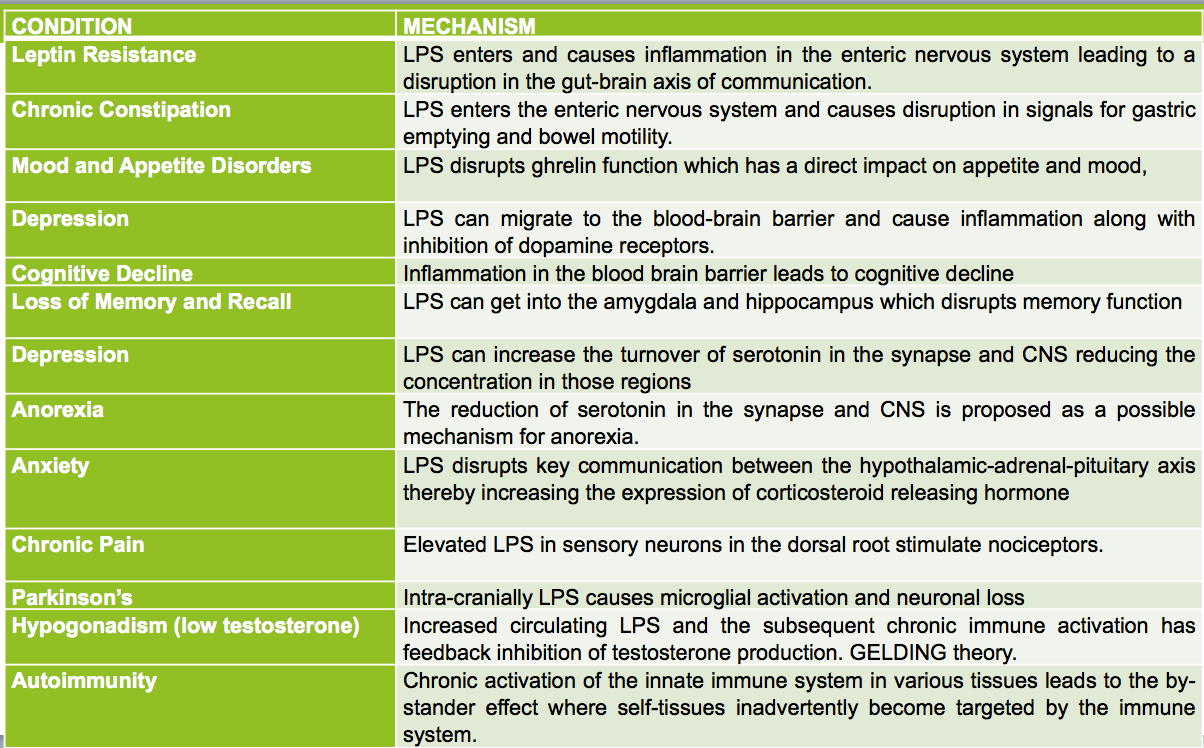Dr. Jill's Tips
Toxic Overload From Within… Metabolic Endotoxemia
We now know there are strong associations between gut health, inflammation, and slow metabolism, weight gain, and diabetes. Although we have known there was a connection for quite a while we weren't sure was exactly how this was happening.
You've probably heard of leaky gut, where the gastrointestinal lining has issues with increased permeability allowing particles to flow into the bloodstream. These are particles, bacteria and waste and antigens, like undigested food proteins that have no business being there. We're finding one particle in particular is causing a lot of trouble – these are called lipopolysaccharides or LPS.
Lipopolysaccharides (LPS) are large complex molecules found in gram-negative bacteria. LPS are endotoxins and when absorbed they can cause a very strong overreaction of the immune system.
The Leaky Gut Cycle & LPS
When a person has intestinal permeability or leaky gut syndrome, these LPS can leak through the gastrointestinal wall and into the bloodstream causing serious, bodywide inflammation. This can cause a vicious cycle of declining health that looks like this:
- Inflammation of the gut lining leading to leaky gut and…
- Poor nutrient absorption (especially vitamin B12, magnesium, and iron), which then causes…
- A strong immune system response to the offending particles, which causes…
- Gastrointestinal issues including food intolerances, celiac disease and eventually leading to various autoimmune diseases.
And autoimmune disease may cause inflammation of the gut lining, which starts this cycle over again. Within this cycle, LPS is pouring from the gut lumen into the bloodstream, causing inflammation, and exacerbating every step along the way.

What is Metabolic Endotoxemia?
When LPS leaks into the bloodstream because of a leaky gut it can cause a condition called metabolic endotoxemia. Metabolic endotoxemia is an increased level of LPS in the bloodstream at two to three times higher than normal concentrations.
This also causes an increased risk of cardiovascular disease and mortality. We've known that obesity and gut dysfunction were associated with the higher risk of heart disease. But now through metabolic endotoxemia, we see a much bigger piece of the puzzle.
Enterotoxemia raises many inflammatory cytokines in the body, such as:
- Interleukin-1
- Interleukin-6
- Tumor necrosis factor-alpha
Through increasing these inflammatory factors, it's believed LPS is the trigger for the onset of insulin resistance, obesity, and diabetes. You regularly hear me touting the importance of reducing are toxic burden. Well, LPS increases your overall toxic burden from within. It’s something most people never think about!
Metabolic Endotoxemia Symptoms
Because endotoxemia occurs after leaky gut, many of the symptoms are similar yet, in it's progressive and later stages.
LPS-induced Endotoxemia is linked to
- Leptin resistance and weight gain
- Chronic Constipation
- Mood disorders such as depression and anxiety
- Cognitive decline and memory issues
- Anorexia and other eating disorders
- Chronic pain
- Parkinson’s disease and Alzheimer’s disease
- Low testosterone
- Autoimmune disease
Symptoms of Metabolic endotoxemia include:
- Food sensitivities
- Histamine intolerance
- Nutrient deficiencies (B12, ferritin/iron, minerals and fat soluble vitamins)
- Autoimmune disease
- Fatigue
- Anxiety and depression
- Weight gain
- Hyperlipidemia and high triglycerides
- Insulin resistance and diabetes
- Inflammation and pain
Evidence Based Interventions to Reduce LPS-induced endotoxemia
- Physical Exercise
- Quercetin
- Curcumin
- Sulphorophanes
- Resveratrol
- EPA DHA omega fatty acids
- Bifidobacteria sp.
- Megaspore probiotic
What Causes Leaky Gut?
Now that we know how a leaky gut causes inflammation, promotes metabolic dysfunction, which can result in obesity and diabetes – you might be wondering what causes this leaky gut in the first place and how can you prevent it?
Factors we know cause increased intestinal permeability include:
- NSAID therapy
- Toxin exposures
- Inflammatory bowel disease
- Small intestinal bacterial overgrowth
- Celiac disease
- Infections
- Food allergy
- Food sensitivities
- Strenuous exercise
- Getting older
- Lack of nutrients
While you can avoid a lot of these, such as NSAIDS, alcohol, and working out too hard, it's even better if you can take steps to build a strong, healthy gut microbiome.
Healing From Within – What Makes a Strong Gut Microbiome?
You can’t look far in the world of health and wellness before coming across how the gut microbiome affects health. This is because your gut microbiome is a cornerstone to your wellbeing and influences biological functions in a very direct way.
Your gut microbiome is particularly important when it comes to your metabolism. In fact, your gut microbiome:
- Breaks down dietary fiber
- Promotes gas production
- Activates fermentation
- Produces phenols
- Breaks down oligosaccharides
- Promotes detoxification
- Produces mucus
- Metabolizes short chain fatty acids
- Supports primary bile acid deconjugation
- Absorbs nutrients and vitamins
- Metabolizes fats
- Promotes triglyceride and cholesterol regulation
We need our microbiomes to be functioning at optimum to keep the gut lining intact and reduce the chance LPS will end up in the bloodstream. Though everyone’s personal microbiome is unique, one factor we know makes for a healthy, resilient, more stable microbiome across all people – is biodiversity.
5 Benefits of a Diverse Gut Microbiome
Just like a diverse ecosystem can withstand changes and remain intact, when a gut microbiome is more diverse it offers you numerous advantages.
Here are 5 benefits of having a diverse gut microbiome:
- A better ability to deal with stressors, such as toxins
- A decreased sensitivity to temporary diet changes
- A reduced risk of disease
- Better weight management
- Healthier metabolism
Overall, with more gut microbiome diversity you get better health resilience – and that is great news for everyone!
3 Ways to Increase Gut Microbiome Biodiversity
Your diet has been shown to rapidly alter your gut microbiome. In one mouse study, changing from a low fat, polysaccharide rich diet to a high fat, high sugar Western diet changed the gut microbiome composition in only one day!
- Eating more fruits and vegetables – Eating a variety of fruits and vegetables, especially those that are high in fiber, have been shown to increase gut microbiome diversity. Especially good are onion, leek, garlic, asparagus, dandelion greens, artichoke, and other non-digestible fibers, like FOS and inulin.
- Avoid sugar-free sweeteners – Non-caloric sweeteners have been shown to cause microbiome imbalance which increases glucose intolerance. When you work on reducing sugar cravings through a better diet, you'll miss sweet things less and less.
- Drink more coffee – Coffee has been shown to increase the Firmicutes to Bacteroidetes ratio of the gut microbiome, which is associated with better metabolism. My new favorite is DOUBLE the antioxidants of any other brand tested… Purity Coffee.
We've been reducing the biodiversity of our gut microbiome through eating highly processed foods, too many sugars, and even by taking probiotics, which only contain maybe 10 species of bacteria.
There are millions of different kinds of bacteria in this world and that little capsule isn’t really doing that much to improve biodiversity. You’re much better off eating a wide range of foods that support a diverse microbiome from within.
Resources:
https://www.ncbi.nlm.nih.gov/pubmed/23943858
https://www.ncbi.nlm.nih.gov/pubmed/17456850
http://www.nature.com/articles/500538a?foxtrotcallback=true
https://www.nature.com/articles/nature1250
https://www.ncbi.nlm.nih.gov/pubmed/24336217
https://www.ncbi.nlm.nih.gov/pmc/articles/PMC2894525/
https://www.ncbi.nlm.nih.gov/pubmed/23985875
https://www.ncbi.nlm.nih.gov/pubmed/25231862
https://www.ncbi.nlm.nih.gov/pubmed/24629912


Are there foods that contain LPS that we should avoid or are LPS made in the body? How are we exposed to them? Where do they come from? Can we reduce our exposure?
Foods don’t contain LPS, bacteria in the gut do… Healing a leaky gut will reduce exposure
You and many others recommend coffee. I have an issue every time I try to get back on coffee. Between the detox of a candida as well as some other issues, my kidneys get overwhelmed within a couple of days. Is there something that you recommend to break through this detox issue. My understanding is that coffee is one of the hardest things on the kidneys when it comes to detoxification.
Dr. Carnahan, I believe I am suffering from this! I have the symptoms. I also had a Genova stool test which indicated levels of enterobacter cloacae bordering on pathogenic. My doctor didn’t choose to advise me on this despite my expressed concern and fear of having a high level of this bacteria inside me. Would taking the two above mentioned probiotics be enough to kill off the enterobacter cloacae? I’ve been afraid to attempt it on my own for fear I would feel ill if I have leaky gut and the dying bacteria enters my bloodstream. What do you suggest to mop up the die off? My doctor is NOT helpful and is not wanting to enter a territory she is not familiar with.
Hi Donna,
You may need herbal or prescription antibiotics to treat the dysbiosis… best to consult with a functional medicine trained physician. You can search by zip code at http://www.functionalmedicine.org
warmly
Dr Jill
Very informative as always Dr.Jill.
Thank you
When I read the abstract linked in the “Drink more Coffee” suggestion, it also states that the coffee increased insulin resistance. It additionally is confusing because it doesn’t isolate the effects of the high fat vs low fat diets; perhaps the high fat – keto-esque – diet is more responsible for the positive effects than the coffee??
Looking forward to Dr. Jill’s response as I had questions along those same lines. Thanks a Dr. Jill!
Hi Kat,
Coffee may prevent diabetes – great research supports this.
warmly
Dr Jill